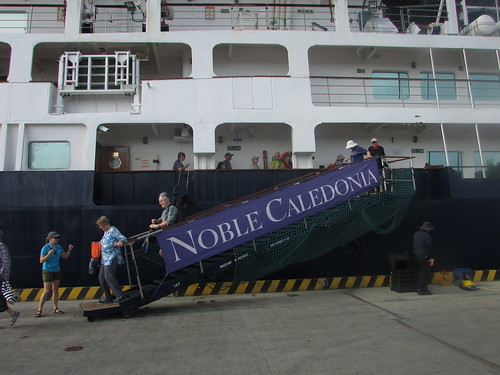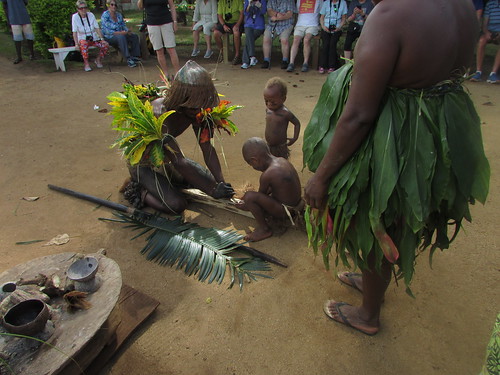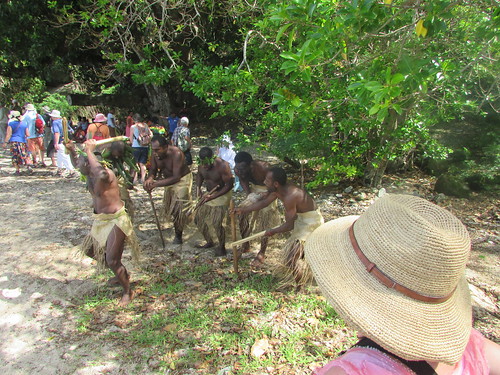Events of Wednesday 19th February 2020
Whilst the guests slept, ‘Caledonian Sky’ sailed to the large island of Espiritu Santo in Vanuatu and about 7 a.m. berthed at the small, modern main quay at Luganville. Two modern transit sheds and stacks of shipping containers just two high confirmed that the quay was the main point for transferring containers between vessel and shore. Two spreader beams (for 40 foot and 20 foot containers) were on the quay, but the expected mobile crane for handling containers (usually in the form of a Reach Stacker at smaller installations) was not visible. At the end of the quay, a covered walkway led up to a modern, brick building which I assumed was used as port offices and passenger terminal for cruise ships.

The quay at Luganville, Espiritu Santo. Note the Transit Shed, substantial bollard, yellow spreader beams, 20 foot container park and, in background, covered walkway to terminal/office building.
I watched, with interest, as members of the ship's crew, assisted by local dock workers, deployed the port side gangway. As they completed the task, a fleet of at least ten people carriers entered the port and lined up on the quay

Members of the ship's crew, assisted by local dock workers, deployed the port side gangway: Luganville, Espiritu Santo

The fleet of people-carriers lined up on the quay: Luganville, Espiritu Santo
After an earlier breakfast, starting at 06:30, a small, energetic group of guests group who fancied river kayaking left by private bus to drive to the kayak pick-up point. The majority of passengers chose to join the waiting fleet of private buses, to the cheerful accompaniment of a local band. I particularly liked the one-string double bass made from a tea chest.

Passengers disembarking at Luganville, Espiritu Santo

A local band welcomed us ashore at Luganville, Espiritu Santo.
When all the passengers had been sorted into the appropriate coach according to which option they preferred after visiting the Cultural Village, the procession of vehicles drove out of the port, turned away from the town and took the road for Leweton Cultural Village.
I’m normally put off by ‘touristy’ cultural villages but I found the visit interesting. A group of dark-skinned warriors and young boys were on hand to alternately threaten us with spears or pose for our photographs.

Leweton Cultural Village, Luganville
We were led to an arena with substantial seating including a thatched roof where a lady in a voluminous skirt and top made from leaves gave some explanation of the demonstrations we were about to watch.
One of the men started to prepare the local drink ‘kava’ by laboriously pounding the vegetable root which is the active ingredient into a grey paste. This paste was then carefully filtered with water through cloth a number of times to produce a whitish liquid. We were told that imbibing the product quickly numbs the lips and few visitors accepted the offer to sample the product from small, half-coconut shells, but I had a couple of sips and thought the flavor ‘odd’. It didn’t compare with any flavour I was familiar with and. Having only taken a small amount, I only noticed a slight numbness around the mouth which quickly passed.

Preparing Kava: Leweton Cultural Village, Luganville.
There was then an impressive demonstration of creating fire using two pieces of carefully-selected wood. A groove in a large, straight piece laid on the ground was rubbed vigorously with a small stick and the smouldering produced was transferred to dried grass allowing a decent fire to result.

Making fire: Leweton Cultural Village, Luganville.
Traditional dances followed, performed first by ladies, then by the colourful male warriors.

Ladies Traditional Dance: Leweton Cultural Village, Luganville.

Men's Traditional Dance: Leweton Cultural Village, Luganville.
For the climax of the show, we moved to a second arena, the centerpiece of which was a deep, blue-tiled swimming pool, complete with semi-circular access steps where a group of six ladies in skirt and top made from leaves plus three young girls stood waist deep in pool water and performed ‘Water Music’. On the shouted command from the leader, the ladies beat the water in synchronism, producing different notes by scooping water sideways with their forearms or striking downwards with their palms, producing an effective, simple tune lasting around twenty seconds. They demonstrated a number of tunes for us, each separated by a short recovery period. I was charmed and delighted by it (if a trifle splashed!).


Water Music: Leweton Cultural Village, Luganville.
Some of our party then continued by bus to Million Dollar Point for snorkelling but most of us continued by bus to Riri Blue Hole, a well-known swimming location supplied by an underground fresh water spring described as “refreshingly cool and set in an exquisite tropical setting of lush jungle” and, allegedly, blue. I’m afraid this location failed to impress me.
We retraced our outward route some 23 km to Luganville town where we had around 45 minutes to explore the covered market and surrounding area. It was rather late in the day to be visiting a market and many stalls had packed-up for the day and not much selling seemed to be going on in the market but I explored the single shopping street as far as time allowed, passing Luganville Municipality Offices (single storey but with, in effect, a porte-cochere tacked on the front, large and modern which at first I took to be a petrol filling station), the small Sanma Police Patrol Office (with solar powered loudspeakers for sounding a Tsunami Warning) and a recreation ground next to the shore with a covered stage (apparently a recent legacy from the 39th Independence Day Celebration). It’s easy to forget that Vanuatu, once French controlled, only obtained sovereignty in 1980.

Market, Luganville, Espiritu Santo.

Municipality Offices, single storey with modern 'porte-cochere': Luganville, Espiritu Santo.

Recreation Ground with covered stage next to the shore: Luganville, Espiritu Santo.
Our buses picked us up and returned us to the ship, passing a long line of shops, banks, travel offices, and the Northern District Police Headquarters. The skiffle band which has welcomed us on the quay when we disembarked were there to play again.
I took lunch on the Lido deck so that, as the ship left Luganville, I could check the other port facilities. Powerful-looking Vanuatu Police Launch ‘Tukoro’ (registered in Port Vila) had moored ahead of us during our excursion ashore, as had the larger Australian Navy ship ‘Leeuwin’, A245.

Vanuatu Police Launch ‘Tukoro’: Luganville, Espiritu Santo

Australian Navy ship ‘Leeuwin’, A245: Luganville, Espiritu Santo.
We passed an older quay still home to a couple of small car ferries and motley craft but the larger vehicle/passenger ship with a stern loading door marked ‘VANUATU FERRY’ which had been moored on our arrival had already left. Next, neatly laid out on the hillside was the oil storage depot and, finally, another old quay storing containers with an adjacent modern warehouse building still under construction.
Whilst we enjoyed lunch, the ship completed the repositioning by 36 km to a spot off Champagne Beach. As the Zodiacs took us ashore, I noted that we appeared to be following a marked channel, suggesting that this might be a popular destination. We made a wet landing over the bow of the Zodiac into warm water and warm, yielding white sand. A snorkel area was indicated on one side of the landing, the swimming area on the other, extending around the wide sweep of the very attractive bay. A large structure with blue painted blockwork lower walls, plaited bamboo upper walls and thatched roof proudly proclaimed “Welcome to Champagne Beach Bar”. There were a few visitors not from the ship already there and the site appeared to enjoy road access.
I stored my shoes at the base of a fallen tree near the landing site, turned the legs of my slacks above the knee and solemnly walked along the sea margin about halfway along the very pretty bay. On my return, the ship’s catering staff were offering drinks but the offered ‘sparkling wine’ didn’t seem to match the name of the beach so I instead accepted a classic Coke.

Champagne Beach, Espiritu Santo.
Most of the guests seemed delighted with the spot but I'm afraid I prefer the properly remote. The Zodiacs returned the passengers to the ship and the ship made ready to sail to the Solomon Islands. I explained in an earlier post here how the spread of the ‘Coronavirus’ had caused an increasing number of countries has started to tighten their entry qualifications for travellers, many imposing a 14-day ‘quarantine’ between leaving a country with a confirmed ‘Coronavirus’ infection and seeking entry to the new country. We had already lost our planned day visiting New Caledonia. Further difficulties arose as we left Vanuatu for our five planned days touring the Solomon Islands. A few weeks before the start of the tour, Solomon Islands had demanded that travellers carried evidence of Measles Vaccination because of an outbreak of measles in the territory. Many of the passengers, including the writer, had to rustle round getting vaccinated because, for the age group of most of the passengers, infection during childhood was regarded as conferring immunity and formal vaccination was not required.
After we had sailed, the Solomon Islands Authorities had decided to impose the ’14-day Quarantine Rule’ for ‘Coronavirus’ which, they calculated, would make travellers via Singapore ineligible for entry on the planned date. But, if entry were later, Noble Caledonia argued that the balance of the tour would be delayed. There was some negotiation between Noble Caledonia and the Solomon Islands Authorities but the travel company decided that the whole five-day programme would have to be deleted and that the ship would spend two additional days within Vanuatu before proceeding directly to Rabaul on Papua New Guinea, missing all the planned Solomon Islands destinations.
Afterword
When I returned home, I found out a little more about the 'Kava' we'd been offered at Leweton Cultural Village. Wikipedia has a comprehensive article here but the most intriguing description of Kava was in the blog here, produced by the Bula Kava House of Portland, Oregon who operate both a bar and on-line sales of Kava!
Related posts on this website
This post is in the series labelled 'Tropic of Capricorn’. The first post is here.
Clicking on the 'Next report' link will display the post describing the next events. In this way, you may read about the trip in sequence.
Next report
Alternately, clicking on the 'All my Tropic of Capricorn reports' link displays all the posts on this trip in reverse date-of-posting order.
All my Tropic of Capricorn reports
My pictures
This blog post was first published on the ship via a satellite link with limited capacity so the links to my pictures were added later.
Luganville, Espiritu Santo
Leweton Cultural Village, Luganville, Espiritu Santo
[Champagne Beach added 25/02/2020: Link to pictures added 10-Mar-2020: Minor edits, pictures embedded 5-Apr-2020]



















